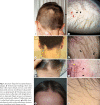Atypical Congenital Triangular Alopecia (Brauer Nevus): Case Report and Review of Literature in Occipital and Mid-Frontal Localizations
- PMID: 34604329
- PMCID: PMC8436702
- DOI: 10.1159/000514698
Atypical Congenital Triangular Alopecia (Brauer Nevus): Case Report and Review of Literature in Occipital and Mid-Frontal Localizations
Abstract
Introduction: Brauer nevus, also known as congenital triangular alopecia (CTA) is a localized alopecia that rarely affects the occipital or mid-frontal region. CTA is a localized follicular hypoplasia, commonly misdiagnosed as alopecia areata. Although named congenital, onset in adulthood is possible.
Case presentation: We present a review of literature of eighteen atypical locations, providing 4 new cases to the 9 previously published, with particular attention to trichoscopy and histopathological descriptions in this exceptional presentation forms.
Discussion: Occipital and mid-frontal Brauer nevus are unusual findings with very few cases reported so far. Because of its rarity and atypical presentation, it can often lead to a misdiagnosis. A higher incidence in the male sex stands clear in these locations. Detection at birth is slightly more frequent than in the classical CTA. Histopathological and trichoscopy findings do not differ from the classical entity, although white or hypopigmented hairs do not seem to be an item present in the mid-frontal forms.
Keywords: Alopecia; Atypical location; Brauer nevus; Follicular hypoplasia; Trichoscopy.
Copyright © 2021 by S. Karger AG, Basel.
Conflict of interest statement
The authors have no conflicts of interest to declare.
Figures


Similar articles
-
Brauer Nevus of Eyebrow: A Rare Entity.Int J Trichology. 2020 May-Jun;12(3):124-125. doi: 10.4103/ijt.ijt_8_20. Epub 2020 Aug 14. Int J Trichology. 2020. PMID: 33223738 Free PMC article.
-
Atypical Presentation of Congenital Triangular Alopecia: A Case Series in Italy.Dermatol Pract Concept. 2020 Oct 26;10(4):e2020122. doi: 10.5826/dpc.1004a122. eCollection 2020 Oct. Dermatol Pract Concept. 2020. PMID: 33150043 Free PMC article.
-
Congenital Triangular Alopecia - A Case Report.Int J Trichology. 2020 Mar-Apr;12(2):89-92. doi: 10.4103/ijt.ijt_4_20. Epub 2020 May 5. Int J Trichology. 2020. PMID: 32684683 Free PMC article.
-
Congenital Triangular Alopecia.Int J Trichology. 2015 Apr-Jun;7(2):48-53. doi: 10.4103/0974-7753.160089. Int J Trichology. 2015. PMID: 26180448 Free PMC article. Review.
-
Differentiation of frontal fibrosing alopecia and Lichen planopilaris on trichoscopy: A comprehensive review.J Cosmet Dermatol. 2022 Jun;21(6):2324-2330. doi: 10.1111/jocd.14457. Epub 2021 Oct 18. J Cosmet Dermatol. 2022. PMID: 34661965 Review.
References
-
- Ferrando J, López Jiménez MT, Navarra R. Alopecia triangular congénita. Actas Dermosifiliogr. 1992;83:657–9.
-
- Yamazaki M, Irisawa R, Tsuboi R. Temporal triangular alopecia and a review of 52 past cases. J Dermatol. 2010;37((4)):360–2. - PubMed
-
- Fernández-Crehuet P, Vaño-Galván S, Martorell-Calatayud A, Arias-Santiago S, Grimalt R, Camacho-Martínez FM, et al. Clinical and trichoscopic characteristics of temporal triangular alopecia: a multicentre study. JAAD. 2017;75:634–7. - PubMed
-
- Happle R. Congenital triangular alopecia may be categorized as a paradominant trait. Eur J Dermatol. 2003;13((4)):346–7. - PubMed
-
- Monteagudo-Sánchez B, León-Muiños E, Vázquez-Golpe R, Carballal M. Alopecia triangular congénita en la región occipital. Piel. 2006;21((7)):364–5.
Publication types
LinkOut - more resources
Full Text Sources

